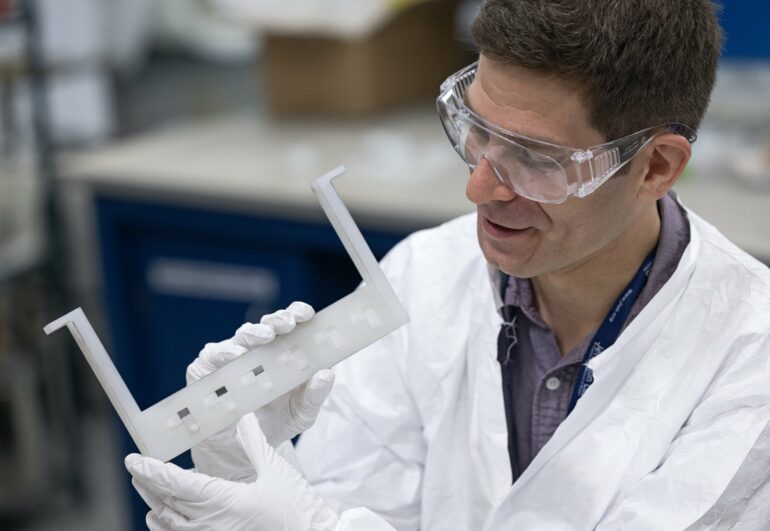Particle accelerators are pricey, but their cost comes with good reason: These one-of-a-kind, state-of-the-art machines are intricately designed and constructed to help us solve mysteries about what makes up our universe. Still, the scientists and engineers building these machines must do their best to save where they can. Researchers at the U.S. Department of Energy’s Thomas Jefferson National Accelerator Facility are supporting this mission by figuring out how to optimize cavities, one of the most critical parts of an accelerator.
Cavities are tubes made of niobium, a metal that becomes superconducting at extremely cold temperatures, allowing the cavities to conduct large electromagnetic fields that they channel to efficiently accelerate particles. Higher fields in a cavity mean the overall accelerator can be shorter.
“Your accelerator can be only 10 miles long instead of 20,” said Charles Reece, a senior accelerator physicist who retired from Jefferson Lab last year. “That’s real estate. That’s big cost savings.”
A cavity’s field, however, can’t be turned up infinitely without consequence. If it’s too high, the cavity will overheat and lose its superconductivity. To produce cavities that can support the highest accelerating fields, labs use different recipes to prepare niobium. For example, one process developed at Fermi National Accelerator Laboratory cooks cavities at 300° Celsius.
“Using this process, they found an enhancement in the performance of their cavities, but no one understood really what was going on,” said Eric Lechner, a staff scientist at Jefferson Lab. In work published three years ago, Lechner, Reece, and other researchers investigated samples prepared following this recipe using secondary ion mass spectrometry, which allowed them to study the composition of the niobium’s surface.
They found that oxygen was being unknowingly introduced. When a pure niobium cavity is exposed to air, oxides form on its surface. During heating, the oxides dissociate, and their constituent oxygen atoms dissolve a few micrometers into the niobium crystals’ crevices.
Back then, Jefferson Lab accelerator scientists began to develop a mathematical model that describes this oxygen diffusion. In work published in April in the Journal of Applied Physics, they further expand and verify this model, which has since matured to predict how more sophisticated recipes affect oxygen diffusion and cavity performance.
“This model describes how the native oxide on the surface of niobium dissociates and diffuses into the surface as a function of temperature and time baked,” said Reece. “We can use it to tailor the surface preparation precisely in order to get the best possible and most reliable performance.”
A wider reach of recipes
Previously, the model described the 300° Celsius vacuum heat treatment. During that process, only the niobium pentoxide breaks down on the niobium surface. However, higher temperatures, as well as much longer bakes at 300° Celsius, are also commonly used to prepare niobium cavities where additional oxide components decompose.
Lechner prepared niobium samples according to these other recipes. Secondary ion mass spectrometry, which was conducted by Jonathan Angle, a former graduate student at Virginia Tech, showed that the model could capture the essential features of oxygen migration in these more complex vacuum heat treatments.
The researchers then extended the model to describe the variations in superconducting properties due to oxygen content introduced during surface preparation. They applied the model to past experiments to link oxygen content with resultant cavity performance.
Low temperature baking typically involves heating a cavity at 120° Celsius for 24 to 48 hours. This type of recipe has been used for the past 20 years because it produces cavities that can handle higher fields—but why it works remains a mystery.
“We asked ‘Can we use our model to investigate whether or not oxygen diffusion is related to this phenomenon?'” Lechner said. The team compared the model to past low temperature experiments, and they agreed well, suggesting oxygen diffusion is indeed behind the performance boost.
Further analysis allowed the researchers to link variations in surface oxygen content with the peak field of the cavity. The results led the researchers to believe that the oxygen is changing the behavior of the niobium to prevent the formation of magnetic vortices in the material that can form in high fields. These magnetic vortices produce heat, limiting the cavity’s performance. The oxygenated niobium allows the fields to be turned up higher without making these vortices and producing too much heat.
“The work shines light on the possible mechanism behind low temperature baking, which continues to be a mystery. Our modeling suggests where to look for additional experimental confirmation of this hypothesis,” Lechner said. “There are other materials that are being developed for particle accelerator cavities, and understanding this phenomenon might translate to those as well.”
Predictive power
In addition to explaining why past recipes worked, the model shows how they could be improved.
“We’ve made significant inroads into understanding the material characteristics enough to gain some predictive power,” Reece said. “We understand enough now to take the guesswork out. That can translate into big savings in the construction of accelerators.”
Teams preparing cavities for various accelerator projects can use the model to develop a process that will yield desired properties. These processes might involve tailoring the starting conditions, such as deliberately adding a specific type of oxide to the niobium’s surface. The model also suggests that more oxygen diffused deeper into niobium will better prevent the formation of vortices.
“For low temperature baking, our model suggests that if you can load the surface with oxygen, you might be able to get better performance,” Lechner said.
Niobium processing is expensive and exclusive; only a handful of places in the world can do it. Accelerator scientists hope to one day fully replace niobium cavities with copper cavities coated in a thin film of niobium using deposition techniques.
“This work, which describes oxide dissolution into thin films of niobium, informs how you would do that,” said Reece. “We’ve had a research program at Jefferson Lab that has been wrestling with developing the techniques to do this for a long time, and they’re making progress.”
In the meantime, the researchers hope their model will help tweak recipes for cavities in future experiments.
More information:
E. M. Lechner et al, Oxide dissolution and oxygen diffusion scenarios in niobium and implications on the Bean–Livingston barrier in superconducting cavities, Journal of Applied Physics (2024). DOI: 10.1063/5.0191234
Provided by
Thomas Jefferson National Accelerator Facility
Citation:
Oxygen tweaking may be key to accelerator optimization (2024, July 11)



